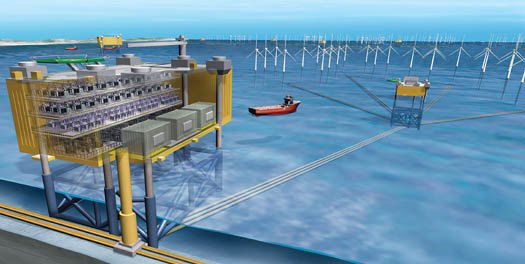I have a feature story in the latest issue of Popular Science: “Hundreds of Miles of Wind Farms, Networked Under the Sea.” It’s about the Atlantic Wind Connection, a new project (funded, in part, by Google) that would lay high-voltage transmission lines beneath the sea floor along the mid-Atlantic coast, opening the area up to offshore wind developers. I managed to get through the article without using the tired term “game changer,” but … this is a Big Deal. Here’s how the story begins:
During the last ice age, glaciers a mile high pushed several dozen cubic miles of rock, sand and debris into the ocean off North America’s mid-Atlantic coast, creating a broad shelf that extends up to 40 miles offshore. This long, flat stretch of seabed and the shallow, windy waters that cover it make the ideal spot for dozens of offshore wind farms—and if all goes well, the network that would link those turbines together and back to the coast will soon be in place.
Offshore wind power has significant advantages over the onshore variety. Uninterrupted by changes in terrain, the wind at sea blows steadier and stronger. Installing turbines far enough from shore that they’re invisible except on the very clearest days lessens the possibility of not-in-my-backyard resistance. The challenge is getting the electricity back to land, to the people who will use it.
The Maryland-based transmission-line company Trans-Elect proposes to do just that with a $5-billion undersea power grid that would stretch some 350 miles from northern New Jersey to southern Virginia. The Atlantic Wind Connection (AWC) would provide multiple transmission hubs for future wind farms, making the waters off the mid-Atlantic coast an attractive and economical place for developers to set up turbines. The AWC’s lines could transmit as much as six gigawatts of low-carbon power from turbines back to the coast—the equivalent capacity of 10 average coal-fired power plants.



